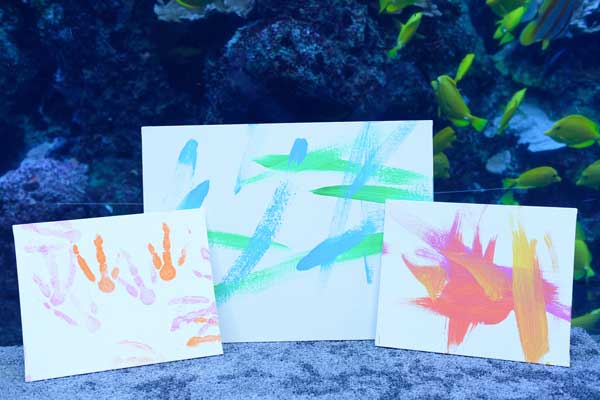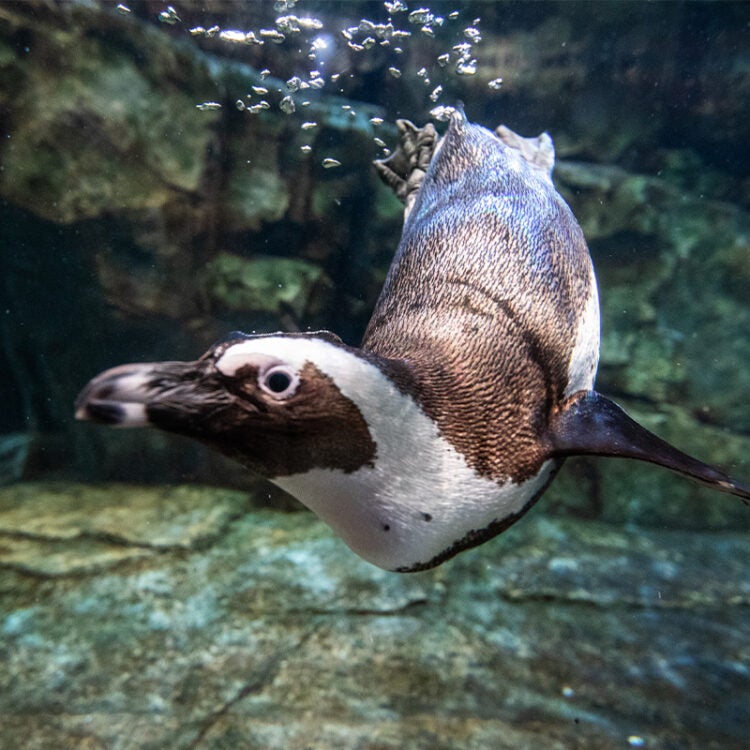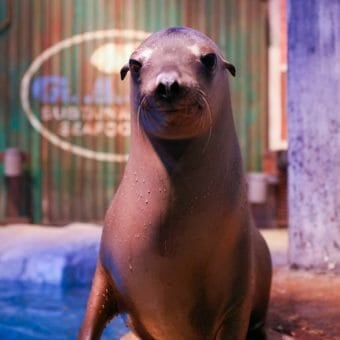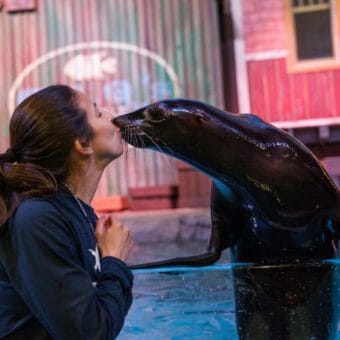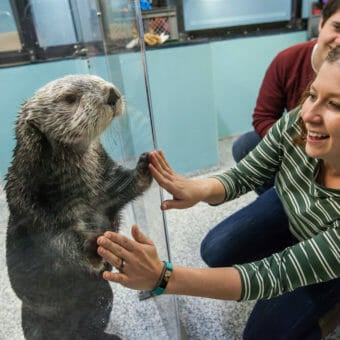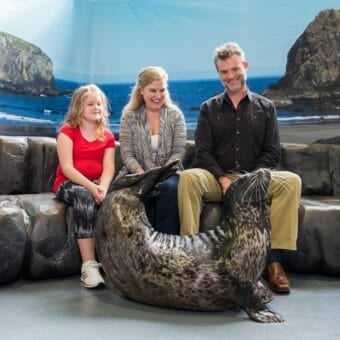-
Size
18-25 inches (46-64 cm) tall -
Diet
Fish, crustaceans, squid -
Range
Southernmost coast of Africa -
Habitat
Temperate climates near water
Physical Characteristics
Size
- The adult African penguin stands 18 to 25 inches (46-64 cm) tall and weighs 6 to 7 lbs. (2.7 – 3.2 kg).
Appearance
- Black back and a white breast. The chest and belly may also have black markings. The white color extends in a semicircular pattern behind and over the head. A horseshoe-shaped black stripe extends across the chest and flanks. Bare flesh-pink skin surrounds the eyes.
- Juvenile feathers are shades of grey with a lighter belly and chest. They maintain their juvenile feathers for one year post-fledging when they molt to their adult plumage.
- Both sexes look the same, which means they are not sexually dimorphic.
Feathers/Allopreening
- Penguin feathers are stiff and overlap in layers to trap air next to the skin for insulation. The feathers are very resistant to wind and water.
- The birds waterproof themselves by using their beak to spread oil from a gland at the base of the tail.
- African penguins are often seen preening each other (allopreening). Allopreening helps birds preen clean and arrange feathers in areas they cannot reach, such as their neck.
- Allopreening plays a role in strengthening bonds between mates.
Molt
- Before their yearly molt, penguins feed avidly, putting on extra weight in the form of fat.
- Molting generally takes place during the summer months. It can also be common to see some birds molt outside of these seasons.
- The molting process is stressful because these birds lose their thermal protection and are unable to hunt for food or swim.
- Molting takes approximately two weeks. They fast during this time, lose weight, and become listless.
- It takes another four to ten days for new feathers to grow in and become waterproof. Only then can the penguin return to the sea to feed.
Bones
- The bones of penguins are solid, unlike the hollow bones of flying birds, to increase body weight and provide ballast when diving. The solid bones of the penguin make the bird too heavy to fly.
Wings
- The wings of this flightless bird are modified flippers for swimming.
- The wing bones are flattened and broadened to take the thrust of water.
- The surface of the wings is covered with scale-like feathers.
Animal Fact
African penguins have a layer of blubber underneath their skin.
Diet / Feeding
Diet
- Diet consists of a variety of marine species; twenty-five species of fish (which make up 42 percent of its diet), eighteen species of crustaceans, three species of squid, and one species of polychaete (worms).
Feeding Behaviors
- Feeds at sea, frequently foraging 9 miles (14.5 km) from its rookery area, and occasionally as far as 60 miles (96.6 km) offshore in search of food.
- Swallows food whole.
- Barb-like structures on the roof of the mouth help them grasp the fish.
Range / Habitat
Range
- Occurs on the southernmost coast of Africa.
Distribution
- Found in temperate climates near water that is between 40 to 70 degrees F (5 – 20 degrees C).
Habitat
- Breeds on 24 islands offshore between Namibia and Port Elizabeth, South Africa. On the mainland, there are colonies of African penguins in South Africa’s Betty’s Bay and Simonstown, as well as in Namibia.
Reproduction & Growth
- African penguin pair-bond for life. Prior to mating, the penguins bray and flap flippers in unison. Breeding occurs all year but peak times are November and March. There are two broods a year.
- Two (sometimes 3 or 4) whitish eggs are laid and incubated for 38-42 days. Both parents sit on the nest and tend to their young, relieving each other daily.
- After hatching, chicks are fed by the parents for up to 3 months, until they molt their down and grow their juvenile feathers. This process is called fledging.
Conservation Status
- “Endangered” on the IUCN Red List
Threats
- Natural predators include South African fur seals, sharks, kelp gulls, skuas, and sacred ibis.
- Gulls and ibises devour up to 40 percent of eggs before they hatch and also prey on penguin chicks.
- Human impact includes oil spills, habitat degradation from guano collection, food shortages from fisheries
- Guano (bird droppings) is rich in nitrogen compounds. Guano is removed from shoreline rookery areas, processed, and made into fertilizer, which is then sold around the world.
Conservation
- People have begun to take steps to preserve the populations of the African penguin:
- Known areas where African penguins breed have been set aside as nature reserves or national parks and fences have been constructed around their breeding grounds. This prevents predation on eggs and young by some natural predators.
- Prohibiting the collection of eggs and guano.
- Establishing marine protected areas where fishing is prohibited.
- The South African National Foundation for the Conservation of Coastal Birds has rescued many of the species from oil spills and has rehabilitated them for return to their natural environments.
Additional Information
Lifespan
- 10-15 years in their natural environment.
- Mid to late-20s in human care.
Communication
- They emit a loud, harsh call, similar to a donkey, to communicate.
- Very vocal, they have a variety of vocalizations that they make to communicate different things (i.e. courtship/mating, territorial/aggression, calling to mate/chicks, etc.)
Lungs
- Lungs are protected from increased water pressure by air sacs that compress as the bird dives.
Nasal Glands
- Penguins must excrete the excess salt that they take in when they swallow seawater with their food. They have specialized nasal glands that remove the salt from the blood and expel it through the nostrils.
Thermoregulation
- A layer of blubber under the skin helps to keep the penguins warm. If they become overheated, blood vessels in the skin fill with blood, bringing heat from within the body to the surface where it is radiated into the air.
- Featherless patches on their face and feet also allow excess heat to escape.
Vision
- These birds are near-sighted on land but have excellent vision underwater.
Swim Behavior
- The penguin often porpoises, plunging in and out of the water, as it swims in order to renew air inside its lungs without interrupting forward progress.
Swim Speed
- It travels at a speed of 4 to 6 miles per hour (6.4 – 9.7 km per hour) while porpoising, but can reach up to about 12.5 miles per hour (20 km per hour) for very short bursts.
Sources
Unique Gifts from Georgia Aquarium
Bring the memories home with you! Stop by our gift shop for all your penguin gifts or shop online here.
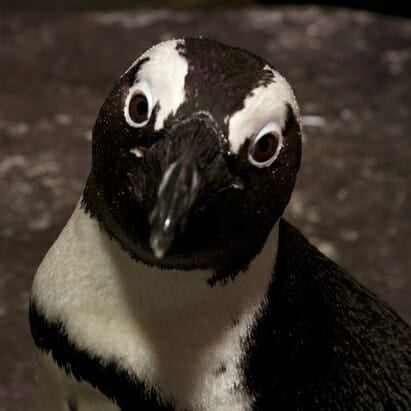
Penguin Paintings Now Available!
Artists come in all different shapes, sizes and species! For the first time, you can purchase a unique piece of art that serves as an incredible conversation piece, or an unforgettable gift. Pieces are created by our animals getting in touch with their inner artist during one of their favorite types of enrichment – painting! Learn more here.
